Visiting Iceland In Winter: Weather, Activities & Survival Tips
Discover Why Families Should Visit Iceland In Winter
A visit to Iceland in winter is an opportunity to experience a unique and exciting wonderland of snow-covered volcanoes, frozen waterfalls and beautiful ice caves.
If you are weighing up whether to book your family travel in Summer or Winter, we can tell you from first-hand experience that Winter in Iceland is stunning!
We chose winter’s frozen landscapes as the backdrop to our road trip, travelling from Reykjavík to the South Coast with our kids. With simple preparation and the right gear, a winter trip to Iceland is an incredible adventure for the whole family.
Trekking The Dream! contains affiliate links and is an Amazon Services LLC Associates Program member. We may receive a commission if you purchase using one of these links. This is at no extra cost to you and helps us to keep our site up and running! Please read our privacy policy for more information.

3 Top Things To Do In Iceland In Winter
🌟Take a Glacial Hike and Ice Cave Tour
🌟Watch the power of a Geyser erupt on a Golden Circle Tour
🌟Visit Blue Lagoon or Secret Lagoon
Iceland in Winter
Winter in Iceland falls between November and March. Although wintery conditions can start in September and continue through to April or May.
Exploring Iceland during winter is a truly rewarding family experience. From exploring ice caves to watching the Northern Lights, winter brings a unique charm that summer can’t match.
Weather In Iceland In Winter
Icelandic weather can be unpredictable, particularly in winter, with snow, rain, sun, ice and strong winds. Despite its proximity to the Arctic Circle, winters are milder than some of its neighbours.
With average temperatures between -1°C & -10°C, you’ll need to dress appropriately. Inland areas tend to be colder than coastal areas, but wherever you are, wrap up warm!
Daylight Hours In Iceland In Winter
Expect 4 to 7 hours of daylight in winter. December and January don’t see sunrise until late morning; by early afternoon, it will set.
The shorter days of winter are the perfect opportunity to embrace the snowy scenery and relax in Iceland’s hot geothermal pools. Aurora seekers can take a tour or seek out somewhere dark for a chance to spot the magical lights.
Is It Worth Visiting Iceland In Winter?
A visit to Iceland in winter is a magical, cosy, bucket-list-filled experience. The reduced daylight hours mean more time for after-dark adventures. We can confidently say that a winter trip to Iceland is worthwhile!
You have a great chance to see the Northern Lights and many family-friendly snow activities. Skiing, snowmobiling, dog sledging, and building snowmen in the unique landscape are just some of the great benefits of a family trip to Iceland in winter.
Reykavik or Vik and their surrounding areas are great destinations to stay in Iceland in winter.
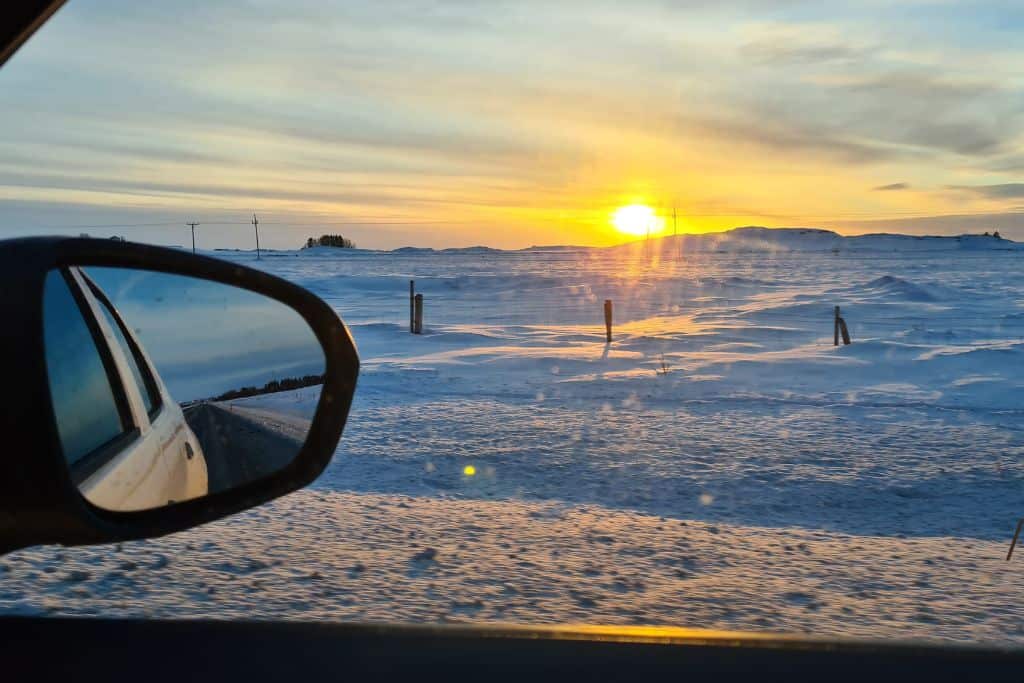
10 Things To Do In Winter in Iceland
Iceland is a great family destination year-round, but winter is when visitors can see the land of fire and ice in all its glory.
1 | See The Northern Lights
One of Iceland’s main attractions in winter is seeing the Northern Lights. Also known as the Aurora Borealis, the natural light display is best seen on clear nights that have high solar activity – which happens often in Iceland!
Popular viewing spots for the light show include remote areas such as the Thingvellir National Park, Jökulsárlón Glacier Lagoon, and the Westfjords, away from the bright lights of Reykjavik.
While you can spot the light displays yourself, you have a better chance of seeing them from an optimal viewing spot on a Northern Lights Tour. Alternatively, book domed accommodation in a remote location for a private viewing of Aurora dancing the night away.
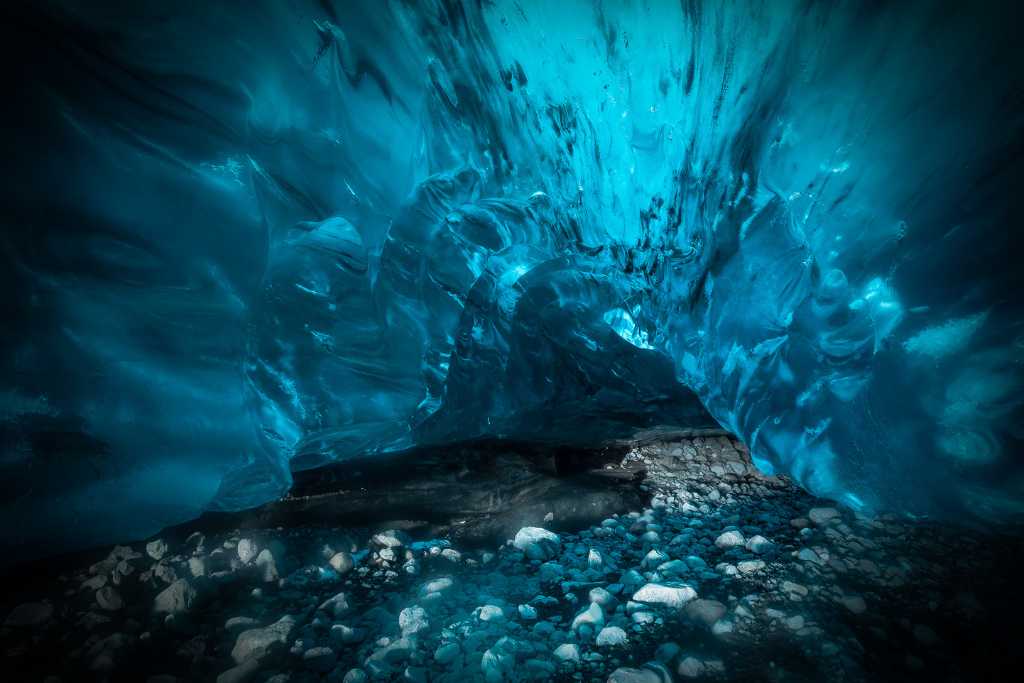
2 | Take A Glacier And Ice Cave Tour
For a unique winter activity, head to Vatnajökull, Europe’s largest glacier, where you can hike on glaciers and explore ice caves with a family-friendly guide.
Kids will love the excitement of this educational and fun adventure.
While in surrounded by towering blue ice formations, kids will amuse themselves by sliding on the icy ground, making it one of the best things to do on an Icelandic winter trip!
3 | Warm Up In A Geothermal Pool
Relaxing in a geothermal pool is an iconic ‘must-do’ activity in Iceland.
The popular family-friendly Blue Lagoon and Secret Lagoon (over 12 years old only) are particularly magical in winter. The mineral-rich water will be even more relaxing, and the low air temperature will create more steam! The warm pools are perfect for kids to splash around and relax while the rest of the family enjoys the views and therapeutic benefits.
For a free, authentic Icelandic experience, venture to the hot springs in Reykjadalur Valley and relax like a local or nip to a public pool for a more traditional outing.
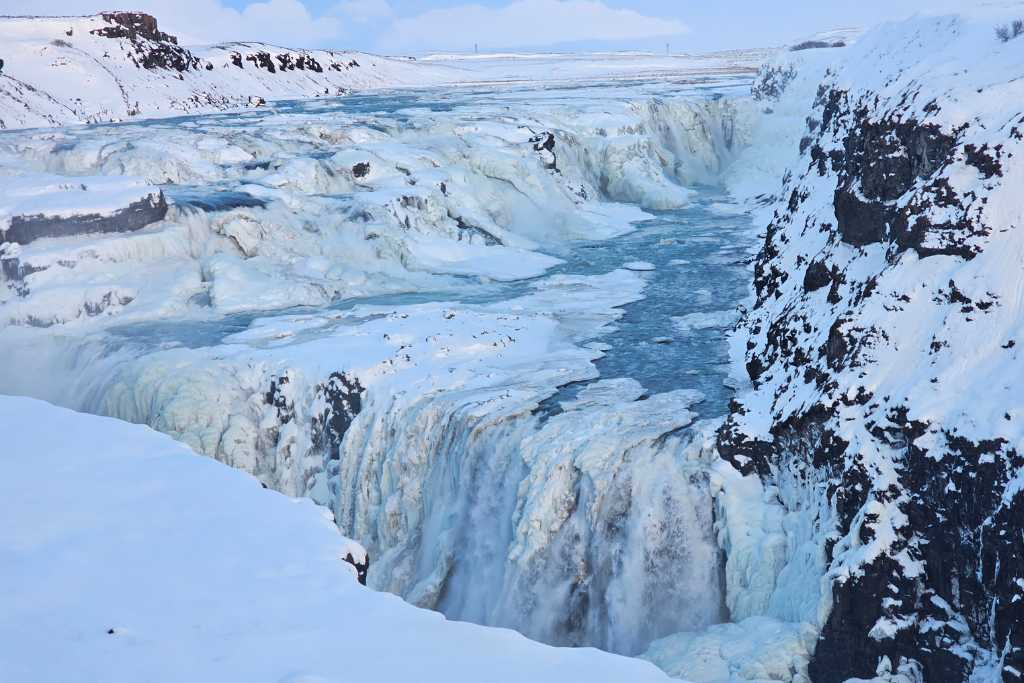
4 | Tour The Golden Circle
The Golden Circle is a popular route, easily accessible from Reykjavik even in winter. It is a fun and engaging way to explore Iceland’s natural wonders in winter by guided tour or self-drive.
The iconic circular route has famous Icelandic sights such as Thingvellir National Park, Geysir geothermal area, frozen Gullfoss waterfall and Karid Crater. These are some of the impressive stops on the route.
You can easily complete The Golden Circle in a day trip from Reykjavik, with relatively short distances between stops.
5 | Road Trip To Icelands South Coast
A winter road trip is the ultimate way for families to explore Iceland’s top attractions at their own pace.
Kids will eagerly anticipate each stop on your road trip itinerary. From encountering frozen waterfalls, black sand beaches, plane wrecks, glaciers and unique rock formations, the adventure never gets boring on the South Coast.
A winter road trip in Iceland is a journey of discovery and will likely leave you wanting to go back to see it all again in the summer.
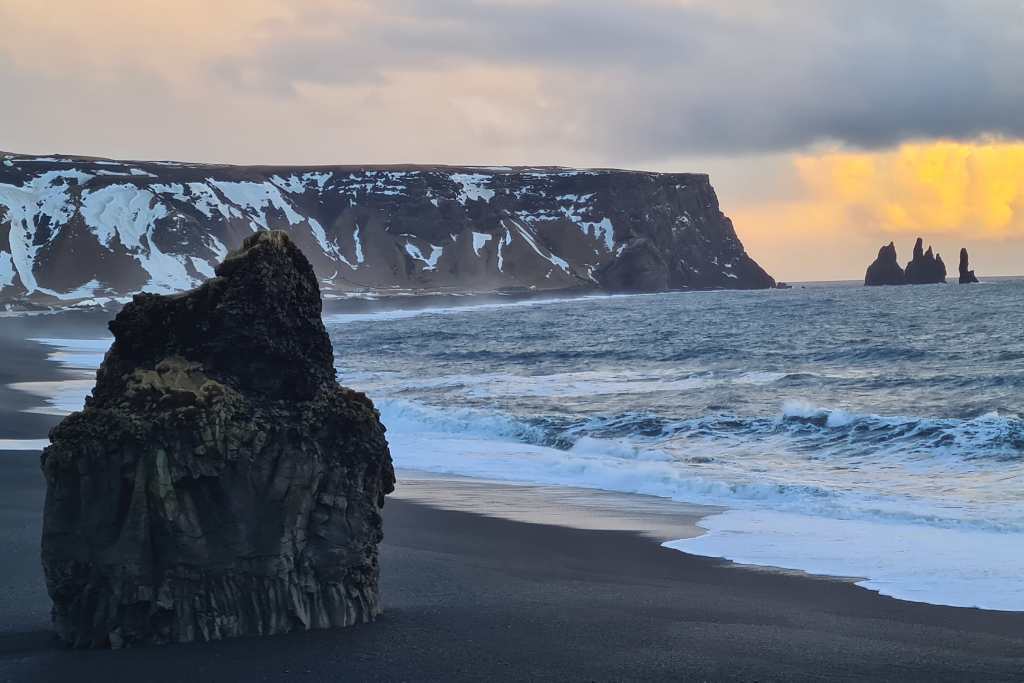
6 | Visit Black Sand Beaches
Visiting Iceland’s black sand beaches in winter is an exciting and memorable activity for families with kids.
The surreal contrast with black sand against white snow in winter showcases Iceland’s wild, natural beauty.
The most visited black sand beaches are Reynisfjara, which offers dramatic views of towering basalt columns, and Diamond Beach, for its impressive washed-up ice burgs.
7 | Snow Activities
Iceland is a great place in winter for fun, family snow activities and making great memories with kids.
There is no shortage of things to do in winter, from snowmobiling across glaciers to dog sledging or ATV adventures. If you find fresh snowfall, join your kids in a snowball fight or make a giant snowman together.
8 | Chase Frozen Waterfalls
Iceland is known for its waterfalls, which transform in winter into partially frozen wonders with dramatic icicles overhanging the drop.
Many of Icelands’ frozen waterfalls, like Seljalandsfoss, Skógafoss, and Gullfoss, are accessible in winter. Be careful and wear your grippers, as the surrounding pathways freeze in winter, and access may be limited.
9 | Celebrate Christmas And New Year
Spending Christmas and New Year in Iceland with kids guarantees a magical experience filled with festive cheer, unique traditions and natural winter scenes.
The holiday season lights up with colourful decorations, Christmas markets, and the charming folklore of the 13 Yule Lads—mischievous characters that leave small gifts for kids. Take a Christmas city tour to learn more about Icelandic traditions.
Reykjavík hosts events, creating a festive atmosphere that kids will love. On New Year’s Eve, bonfires and spectacular fireworks light up the sky for memories to be made, bringing in the New Year in Iceland’s winter wonderland.
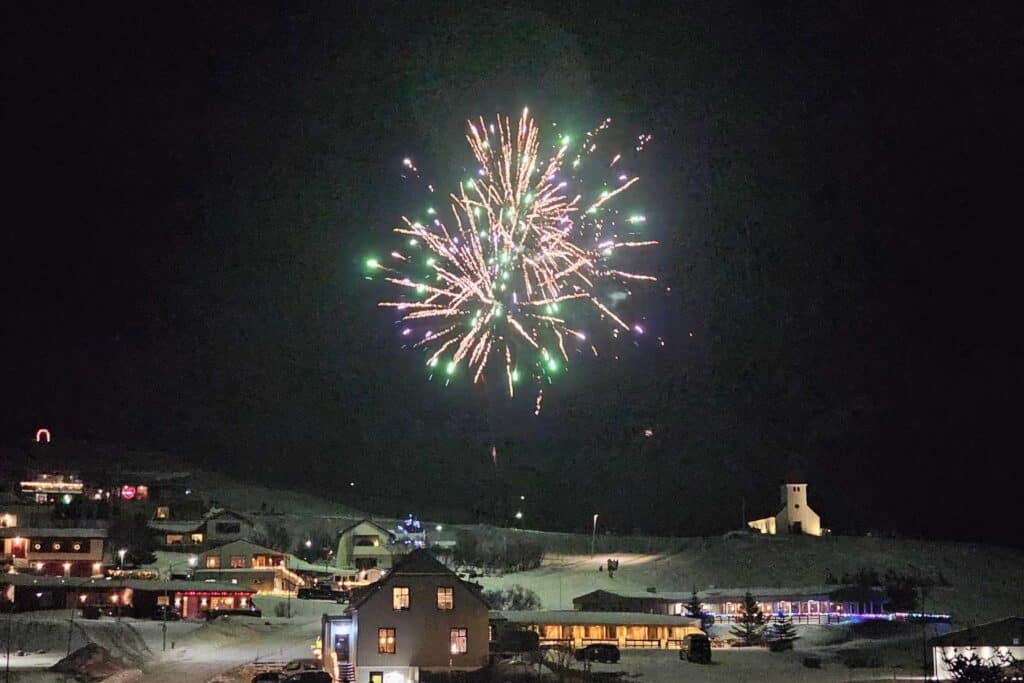
10 | Discover Reykjavík In Winter
Reykjavík is a lively, fun, festive city with lots to see and do in winter. The capital’s cultural attractions, such as its family-friendly museums, sculptures, and the impressive Hallgrímskirkja church, are budget-friendly sites to visit with kids.
You can learn about Iceland’s natural wonders through the interactive exhibits at the Perlan Museum. Take a walking tour to hear all about the city from a local; the festive lights, decorations and winter trails add a touch of magic!
Once you’ve exhausted sightseeing, treat your family to a soak in one of the city’s geothermally heated public swimming pools or warm up with a hot chocolate in a cafe.
Tips for Winter Travel In Iceland
Iceland is an accessible country with care in winter, here are some tips for a safe family trip.
❄️Driving Iceland In Winter
Driving on wintery roads can be challenging, especially in remote areas where they may not have been fully cleared. Many cross-country roads are closed in winter, but this will not stop you from exploring.
The main roads are usually kept reasonably clear, but visibility in snow or sleet can be challenging. Renting a 4×4 vehicle fitted with winter tyres and keeping tabs on the weather before setting out on the roads is essential to ensure you stay safe.
❄️Pack Properly Before Visiting Iceland In Winter
Dress in breathable layers for warmth with waterproof outerwear, hats, gloves, and sturdy boots. Remember that the wind chill factor can make it feel much colder than the air temperature. Ensure you have additional layers available in case you get cold or wet, and consider taking travel boot dryers with you.
❄️Reduced Winter Daylight In Iceland
There are very limited daylight hours in winter, so make sure you plan a flexible schedule of activities that can be completed before nightfall. Accommodation should be arranged well in advance to ensure you have a warm room for the night!
❄️Shoe Grips
These are essential for walking on compacted snow and ice, and we recommend purchasing them before you travel. Without them, you may struggle to stay upright in untreated areas. Some paths are closed in winter, while others remain treacherous to travel. Walking poles are only recommended if you know how to use them correctly.
Visiting Winter In Iceland FAQ’s
To get the most out of your adventure to Iceland in Winter here are a few commonly asked questions:
Iceland experiences winter temperatures of -1°C to -10°C in January with rain, wind, snow, or even sun. Dressing in warm, layered, waterproof clothing will allow you to enjoy a trip to Iceland in January without getting cold.
While Iceland is an excellent location to see the Aurora Borealis, it is not guaranteed in any month but is more likely from October to March. The Northern Lights are only visible with a clear sky after dark, with positive solar activity.
Yes, you can see whales in bays around Iceland in January. Orcas, humpback whales, and dolphins can be spotted on a winter whale-watching trip.
Final Thoughts | Winter In Iceland
Iceland’s serene and rugged beauty has been sculpted by fire and ice over millions of years and is a perfect location for adventure seekers looking to experience nature’s raw power.
There are many winter activities for families to enjoy across Iceland.
Once you’ve explored Iceland in Winter, we’re confident you’ll want to return for more; perhaps take a trip in summer and experience the magic of the midnight sun!
